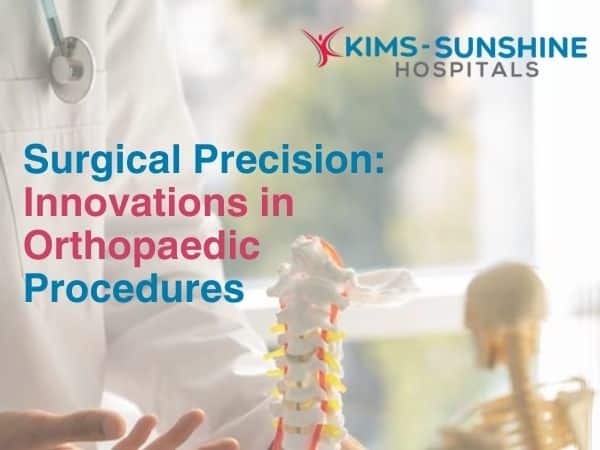
Surgical Precision: Innovations in Orthopaedic Procedures

Orthopaedic surgery has advanced significantly in recent years, and advances in this field have resulted in significant improvements in patient outcomes. Orthopaedic surgeons now have access to cutting-edge technologies and techniques that allow for unprecedented surgical precision. Look into the most recent advancements in orthopaedic surgery, which provide safer, faster procedures and better long-term outcomes.
1. Minimally Invasive Surgery: Orthopaedic surgery has been transformed by minimally invasive techniques. Smaller incisions, less trauma to surrounding tissues, and faster recovery times are all part of these procedures. Arthroscopy, for example, enables surgeons to visualise, diagnose, and treat joint problems using tiny incisions and a camera. This breakthrough has made a significant difference for patients undergoing knee, shoulder, or hip surgery.
2. Robotic-Assisted Surgery: Robotics has made its way into orthopaedics, improving surgical precision. Surgeons can use robotic systems to plan and carry out procedures with unrivalled precision. These systems provide real-time feedback, allowing surgeons to adjust during surgery to achieve the best possible results. Robotic-assisted procedures, whether for joint replacements or spine surgery, provide greater safety and precision.
3. Patient-Specific Implants: Customised implants are becoming more popular in orthopaedic procedures. These implants are custom-made for each patient’s anatomy, ensuring a perfect fit. This personalization lowers the risk of complications, speeds up recovery, and improves the overall success of the surgery. Custom knee and hip implants, for example, have revolutionised joint replacement surgery.
4. 3D Printing: 3D printing has made it possible to create patient-specific implants and surgical guides. Surgeons can now plan complex procedures using 3D-printed models, increasing precision and decreasing operating time. This technology has proven especially useful in spinal surgeries and complex fractures.
5. Biologics and Regenerative Medicine: Biologics and regenerative medicine are increasingly being used by orthopaedic surgeons to promote healing. To stimulate tissue repair and reduce inflammation, platelet-rich plasma (PRP) and stem cell therapies are being used. These novel treatments are altering how we treat soft tissue injuries and osteoarthritis.
6. Navigation Systems: Advanced imaging and real-time tracking are used by navigation systems to guide surgeons during procedures. These systems are particularly useful in complex surgeries such as spinal fusion or joint replacement. They improve accuracy while lowering the risk of complications.
7. Nanotechnology: Nanotechnology is making inroads into orthopaedic procedures, opening up new avenues for drug delivery, imaging, and implant coatings. Nanomaterials can be engineered to improve joint replacement longevity and infection rates.
8. Virtual Reality (VR) and Augmented Reality (AR): Before entering the operating room, surgeons use VR and AR to visualise the patient’s anatomy and practice procedures. This technology enables precise planning and assists surgeons in making critical surgical decisions.
9. Telesurgery: Telesurgery, while not widely used, holds great promise in the field of orthopaedics. Surgeons can use robotic systems to remotely guide and even perform surgeries. This breakthrough has the potential to bring orthopaedic care to underserved communities.
10. Continuous Monitoring and Postoperative Care: Postoperative care innovations are just as important as surgical technique advancements. Wearable devices and remote monitoring systems enable continuous tracking of a patient’s progress following surgery, allowing for early detection of complications and improved recovery outcomes.
In conclusion, orthopaedic surgery has undergone a remarkable transformation, fueled by cutting-edge innovations that have made procedures safer, more efficient, and less invasive. At KIMS-Sunshine Hospitals in Secunderabad, Orthopaedic Hospital Near you, patients can expect faster recoveries, less discomfort, and better long-term outcomes. As technology advances, the future of orthopaedic surgery becomes more promising, giving hope to people suffering from musculoskeletal problems. If you’re thinking about having orthopaedic surgery, we strongly advise you to consult with our skilled surgeons at the best orthopaedic hospital in Hyderabad, KIMS-Sunshine Hospitals in Secunderabad, who are at the forefront of embracing these innovations and ensuring the best possible outcomes for your health.






